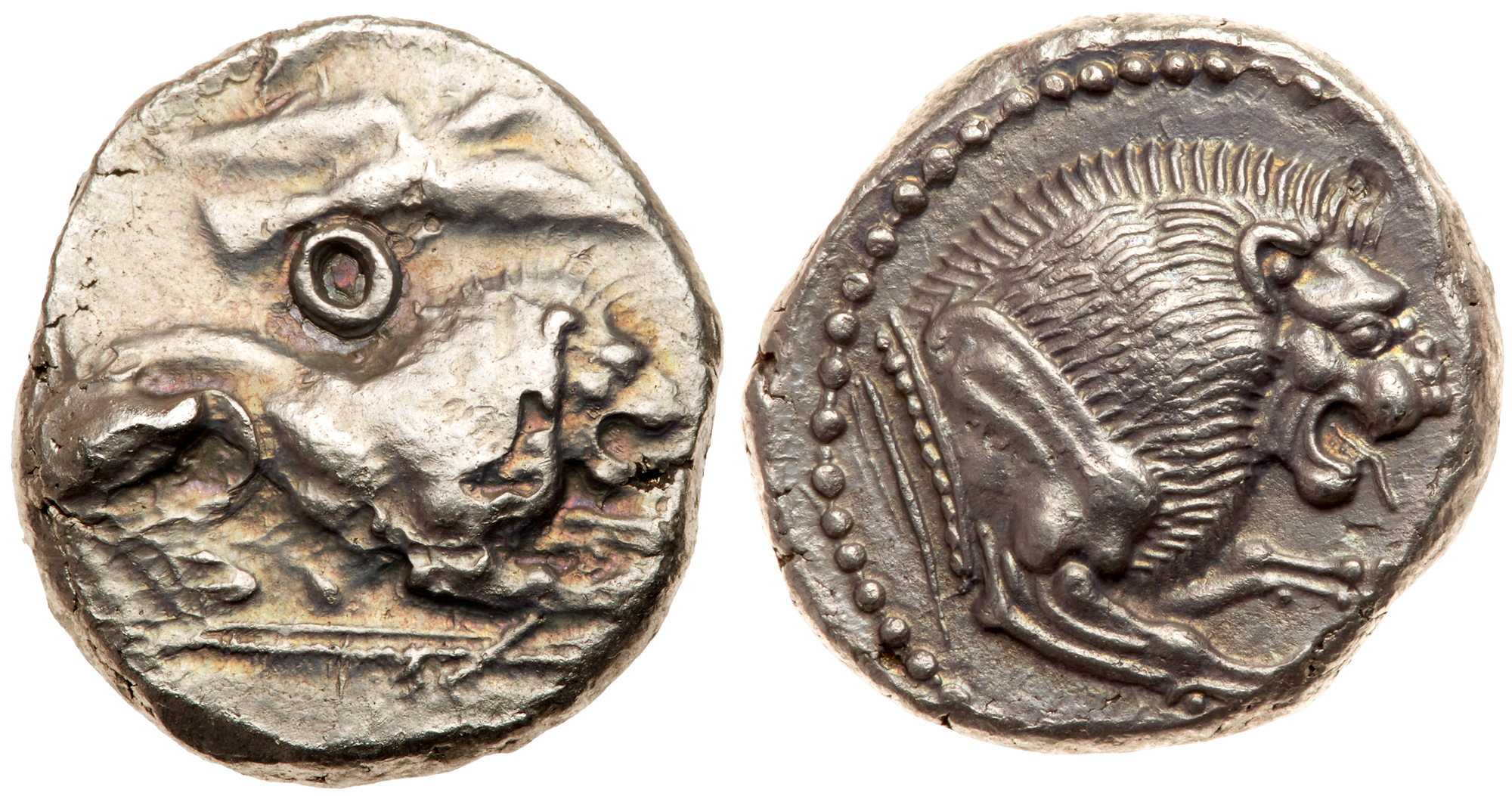S 1578 - Amathus (uncertain king), silver, staters (450-430 BCE)
From SILVER
450 BCE - 430 BCE Silver 260 kg
Description
| ObverseInscription or printing placed on the obverse.: | Lion lying r., above, eagle flying r., in exergue, Cypriot mo |
| ReverseInscription or printing placed on the reverse.: | Forepart of lion r. with open mouth. All within incuse squar |
Mint and issuing power
| MintIdentifies the place of manufacture or issue of a numismatic object.: | Amathus | Ancient regionAncient region.: | Cyprus | Modern countryModern country: Greece | AuthorityIdentifies the issuing power. The authority can be "pretended" when the name or the portrait of X is on the coin but he/she was not the issuing power. It can also be "uncertain" when there is no mention of X on the coin but he/she was the issuing power according to the historical sources: |
Chronology
| FromIdentifies the initial date in a range assigned in a numismatic context. | 450 BCE | toIdentifies the final date in a range assigned in a numismatic context.. | 430 BCE | PeriodTime period of the numismatic object.: Classical 480-323 BC |
Physical description
| MetalThe physical material (usually metal) from which an object is made.: | Silver |
Median weightMedian of the weights of numismatic objects (in grams). in grams | 11.10 | DenominationTerm indicating the value of a numismatic object. Examples: tetradrachm, chalkous, denarius.: | stater |
StandardStandard.: |
Image

S1578 Amathus uncertain stater.jpg [1]
References
| Die study referencePublication of the study: | Amandry 19841Amandry 1984, p. 69-70, n° 126A | ||
| Coin series referenceReference to coin series study: | BMC Cyprus2BMC Cyprus, Amathus, n° 3, Tziambazis 20023Tziambazis 2002, n° 2 | ||
Obverse dies distribution
| FrequencyFrequency of specimen in distribution. ᵖ | Number of obversesNumber of obverse dies. ᵖ (o) | % (o) | Number of coinsNumber of coins. (n) | % (n) | Die nameName(s) of the die(s). |
| 4 | 1 | 100 | 4 | 100 | 1 |
| Total | 1 of 1 | 100 | 4 of 4 | 100 |
Reverse dies distribution
no distribution is available
Quantification
| Number of obversesNumber of obverse dies. ᵖ (o) | 1 | Number of singletons (o1)The number of singleton coins. ᵖ | |
| Number of reverse diesNumber of reverse dies. (r) | 4 | Number of coinsNumber of coins. (n) | 4 |
| Coins per obverse dieNumber of coins per obverse die. (n/o) | 4 | Coins per reverse dieNumber of coins per reverse die. (n/r) | 1 |
| Reverse per obverse ratioRatio of obverse dies divided by reverse dies. (r/o) | 4 | Percentage of singletons (o1)number of coins (n) divided by the number of singletons (o1) ᵖ | % |
| Original number of dies (O) (Carter 1983 formula)The estimation of the number of coins according to Carter 1983 ᵖ | 1.17 | Coins struck if 20,000 as average productivity per dieCoins made if the average productivity for obverses (according to Carter) is 20,000. ᵖ | 23,400 |
| Original number of dies (O) (Esty 2011 formula)The estimation of the number of coins according to the singleton formula in Esty 2011 ᵖ (O) | 1.33 | Survival rate if 20,000 as average productivity per dieSurvival rate if average productivity is 20,000. ᵖ | 0.00017 |
| Coverage (o = % of O) (Esty 1984 formula)Esty 1984 - coverage (% of O) ᵖ (o = % of O) | % | Die productivity if survival rate 1/2,000Average productivity if survival rate is 1/2,000. ᵖ | 6,837.61 |
| Weight of silver (in kg) if 20,000 coins per die (O = Carter formula)Carter 1983 * Median weight * 20000 (*10 if gold or electrum) ᵖ | 260 kg <br /> 260 kg | Die productivity if survival rate 1/5,000Average productivity if survival rate is 1/5,000. ᵖ | 17,094.02 |
Remarks
References
- ^ Amandry, Paris (1984), "Le monnayage d'Amathonte", in Pierre Aupert and Marie-Christine Hellmann (eds.), Amathonte I. Testimonia. 1. Auteurs anciens - Monnayage - Voyageurs Fouilles - Origines - Géographie, Etudes chypriotes 4, Paris, p. 57-76, pl. 11-20.
- ^ Hill, George Francis (1904), A Catalogue of the Greek coins in the British Museum, vol XX : Cyprus, London, cxliv, 119 p., xxvi pl.,
- ^ Tziambazis, Elias (2002), A catalogue of the coins of Cyprus: from 560 B.C. to 1571 A.D., Larnaca, 89 p.